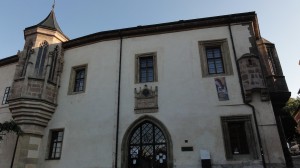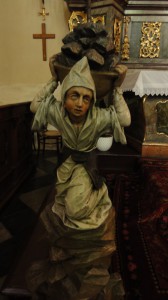Hrádek (The Little Castle) and the Silver Museum in Kutná Hora
By Tracy A. Burns
The history of Hrádek
 Hrádek or the Little Castle, now housing the Silver Museum, is located in the center of Kutná Hora and dates back to 1312 or earlier. It became a stone fortified castle palace before being reconstructed into a family residence at the end of the 15th century. At that time, under the ownership of entrepreneur Jan Smíšek, it was one of the earliest examples of the Renaissance in Bohemia. The extravagant building was decorated in Jagiellonian Gothic style with large halls, a three-floor tower, high gables, and chapels. Mining motifs and painted ceilings add to the stunning décor. Then the owners of the Little Castle changed many times, and during the late 17th and 18th centuries, the place was used as a Jesuit seminary and school. Hrádek underwent Gothic renovations in the 1950s and 1990s.
Hrádek or the Little Castle, now housing the Silver Museum, is located in the center of Kutná Hora and dates back to 1312 or earlier. It became a stone fortified castle palace before being reconstructed into a family residence at the end of the 15th century. At that time, under the ownership of entrepreneur Jan Smíšek, it was one of the earliest examples of the Renaissance in Bohemia. The extravagant building was decorated in Jagiellonian Gothic style with large halls, a three-floor tower, high gables, and chapels. Mining motifs and painted ceilings add to the stunning décor. Then the owners of the Little Castle changed many times, and during the late 17th and 18th centuries, the place was used as a Jesuit seminary and school. Hrádek underwent Gothic renovations in the 1950s and 1990s.
Kutná Hora and mining in the Middle Ages
During the Middle Ages Kutná Hora was one of the most significant towns in Bohemia due to its rich silver deposits. Beginning in the second half of the 13th century, the mining reached its peak during the 14th century, when there were about 2,500 miners, smelters, and craftsmen working in the town’s mines. The annual production of silver was 3,000 to 5,000 kilograms and 50 to 100 tons of copper. From the 13th to the 17th century, 2,500 tons of silver and 20,000 tons of copper were extracted in this town.
The two tours
The first tour of the Silver Museum, called “The Town of Silver,” takes visitors through the vaulted Gothic halls, where they learn about the history of Kutná Hora and the significant economic and political role it once played in society. Visitors see the luxurious lifestyle that some citizens led due to wealth from the mines and also learn about geological and archeological developments as well as the first miners’ settlements. The medieval monetary system is also addressed. A tour of its rich collection of paintings and carvings rounds out the tour. The second tour, called “The Way of Silver,” describes the technology of mining ore and the processing of silver during the Middle Ages. The particular tools and methods used in mining are explained. The highlight of the tour is a visit to an authentic medieval silver mine. Visitors also learn how coins were minted.
The history of the town
The first tour covers the history of the town. In 1142 a Czech nobleman named Miroslav of Cimburk established a monastery in the Sedlec region near Kutná Hora. According to a legend, a monk named Anton first discovered a silver vein in the region on a hill near the monastery. The town got its name because he put a piece of his garment, called a kutná, over the rods.
Archeological finds
Archeological finds in the area are also described. At the Celt’s burial site in Karlov, discovered in the 1980s, 48 skeletons were found in one cremation chamber, and they included men in full armor with shields, swords, and spears as well as women with bronze bracelets and necklaces.
Miners’ settlements and instruments
 The original miners’ settlements in the Middle Ages included wooden and framed buildings, wooden chapels, baths, shops, and pubs. A display case shows the two kinds of hammers that miners used – a sled, which is a round hammer, and a pick or pointed hammer. The miner struck the flat end of the pick with a sled and then drove the pick into the rock. Visitors also see instruments utilized by miners from the 14th to 16th century.
The original miners’ settlements in the Middle Ages included wooden and framed buildings, wooden chapels, baths, shops, and pubs. A display case shows the two kinds of hammers that miners used – a sled, which is a round hammer, and a pick or pointed hammer. The miner struck the flat end of the pick with a sled and then drove the pick into the rock. Visitors also see instruments utilized by miners from the 14th to 16th century.
Cellars, mazhauses, and the town hall
They also learn about the many uses of stone cellars from that period. These spaces were not only used for storing food and wine but also for brewing malt. A craftsman’s workshop could be found in the cellar, too as could access to a well and an emergency fire exit. Luxurious and imported goods were sold in mazhauses, which were ground-floor rooms of wealthy merchants. Visitors also become familiar with the history of the town hall. First mentioned in 1375, it had one of the oldest astronomical clocks in Europe. It has served as a prison and torture chamber, too.
Jan Smíšek’s Chamber
One of the highlights of the tour is the so-called preserved log cabin or Jan Smíšek’s Chamber dating back to the end of the 15th century, in the late Gothic and Renaissance era. The former bedroom of the Smíšek family, it contains replicas of furniture from the turn of the 15th and 16th centuries. It has walls with large windows. The ceiling is diagonally divided into four parts.
The Renaissance Hall and the Knights’ Hall
The Renaissance Hall, which probably served as a private room for the Smíšek family, dazzles with a painted ceiling from 1493. The ceiling and frieze are some of the earliest examples of Renaissance architecture in the Czech Republic. The Knights’ Hall, hailing from the beginning of the 15th century, features a 1551 panel painting showing Czech King Wenceslas II with his influential code of mining from 1300. Two books in this room are extremely valuable – the 1489 Bible of Martin from Tišnov and the hand-written Hymn Book, hailing from 1470 to 1530.
The Feasting Hall, the chapel, and the treasury
The Feasting Hall is a fine example of late Gothic architecture with cross rib vaulting and fragments of original polychromy. The chapel shows off frescoes of Saint Wenceslas and Saint Vojtěch (Adalbert) as well as a ceiling painting of Christ surrounded by four animal motifs symbolizing the four Evangelists. Notice Mark is portrayed as a lion and John as an eagle. The Treasury follows the history of the minting of the Prague Groschen and thaler coins in the nearby Italian Court, where money was produced for 426 years, from the 14th to 18th century.
The second tour
The second tour shows the methods and techniques of mining and processing in the Middle Ages, including descriptions of the tools and transport methods, smelting, the casting of silver, and the minting of Groschen coins. Visitors have the option of descending 160 steps into a medieval mine, walking to a depth of 35 meters. The tunnel is 250 meters long, and the width ranges from 70 centimeters to 40 centimeters. The height changes from three meters to 120 centimeters. Even the sockets where miners placed their oil lamps are visible.
Horse gins and windlasses
In order to transport a load of 70 kg from vertical or sloping shafts, a lift called a windlass was employed. Horse gins or horse-powered winches able to lift more than one ton from a depth of 200 meters were common for long-distance transport. In the garden, there is a replica of a horse gin. A small windlass is also on display.
The Kutná Hora Hymn Book
A large picture shows the front page of the Kutná Hora Hymn Book from the late 15th century. It offers a fascinating and detailed representation of miners’ tools and clothing at the bottom of the page. Ore processing is depicted in the middle of the picture. Ore merchants are portrayed at the top of the page. This rendering gives valuable insight into the medieval world of mining processes.
The art of minting
The tour also addresses the minting of coins. A replica of a mint workshop and replicas of furnaces stand out. The display goes into detail about the three stages of the minting process – the preparatory process, the minting process, and the coining process when silver circles were made into coins.
Familiarize yourself with the history
Mining has had a great influence on the history of Kutná Hora, and there is no better place to acquaint oneself with the significance of silver in the town than the Silver Museum at Hrádek. Visitors are enlightened about the many aspects of mining and coin minting, and the chance to visit a medieval mine is difficult to pass up.



